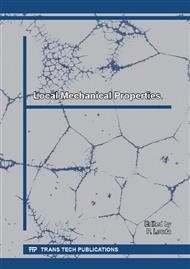p.130
p.134
p.138
p.142
p.146
p.150
p.154
p.158
p.162
Manufacturing and Evaluation of Porous PLA Nano/Micro Fibres
Abstract:
This study is mainly focused on the study of pore size and shape, fibre diameter and also on the optimization of polymer solution composition and electrospinning parameters with respect to the final structure and morphology of PLA nano/microfibrous layers. The nano/microfibres were produced by electrospinning from the needle. Except the spinning process parameters, the morphology of nanofibrous layers can be also affected by the composition of the polymer solution and by the used solvents. Variations in technological process allows us to design the shape and form of nanofibrous structures upon request. The morphology of nano/microfibres was observed by scanning electron microscopy (SEM). Following image analysis and calculation enables the assessment of porosity contribution to the increase in micro/nanofibre surface area.
Info:
Periodical:
Pages:
146-149
Citation:
Online since:
July 2016
Authors:
Keywords:
Price:
Сopyright:
© 2016 Trans Tech Publications Ltd. All Rights Reserved
Share:
Citation:


